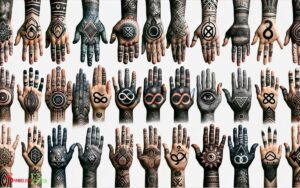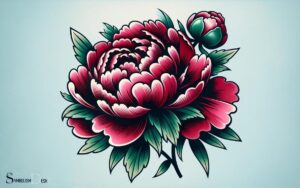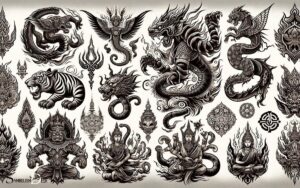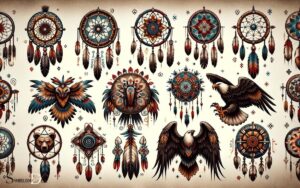Buddhist Symbols and Meanings for Tattoos: Explain!
Explore the profound meanings of Buddhist symbols such as the lotus flower, the Dharma wheel, and the eternal knot in the context of tattoos.
These symbols not only embody significant philosophical and spiritual concepts but also offer a visually appealing design for body art.
By choosing a Buddhist symbol for a tattoo, individuals can carry a piece of Buddhist wisdom and aesthetic with them.
Buddhist symbols are rich in meaning and are often chosen for tattoos due to their spiritual significance and beauty.
Here are a few examples:
- Lotus Flower: Represents purity, spiritual awakening, and enlightenment. It’s a symbol of how we can rise from the mud of our problems and bloom.
- Dharma Wheel (Dharmachakra): Symbolizes the teachings of Buddha and the path to enlightenment. The eight spokes represent the Noble Eightfold Path.
- Eternal Knot (Endless Knot): Stands for the interconnectedness of all beings and the cyclical nature of life. It’s a reminder of the interdependence of all phenomena.
Embrace the wisdom of Buddhist teachings with a tattoo that symbolizes your personal journey toward inner peace and enlightenment.
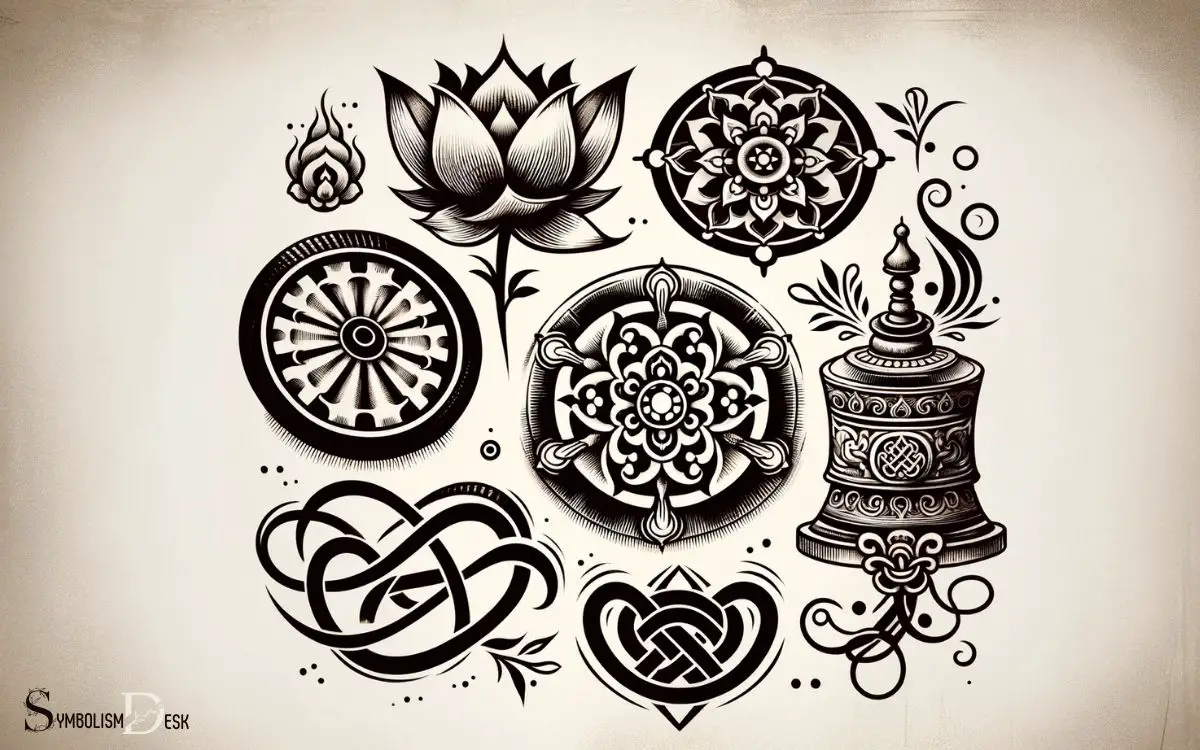
Key Takeaway
The Lotus Flower
The lotus flower holds significant meaning in Buddhist symbolism, representing purity and enlightenment.
This beautiful flower is often depicted as emerging from murky waters, signifying the journey from darkness to light and the ability to rise above worldly temptations.
In Buddhism, the lotus also symbolizes the path towards spiritual awakening, as its petals open to receive the light of the sun.
Its unfolding petals are seen as a metaphor for the individual’s journey towards enlightenment and the blooming of one’s inner potential.
The lotus is a powerful reminder that despite the challenges and obstacles one may face, it’s possible to achieve purity and transcendence.
Transitioning from the symbolism of the lotus flower, the article will now explore the significance of the dharma wheel in Buddhist iconography.
The Dharma Wheel
The Dharma Wheel, also known as the Dharmachakra, holds deep significance in Buddhist culture.
It symbolizes the spiritual journey and the continuous cycle of birth, death, and rebirth. Additionally, it represents the teachings of Buddha and the path to enlightenment.
Symbolizes Spiritual Journey
One of the most significant Buddhist symbols for representing the spiritual journey is the Dharma Wheel.
Also known as the Wheel of Dharma, it symbolizes the teachings of the Buddha and the path to enlightenment.
The Dharma Wheel is often depicted with eight spokes, which represent the Noble Eightfold Path, a fundamental concept in Buddhism.
Each spoke signifies an aspect of the path to spiritual liberation, including right understanding, thought, speech, action, livelihood, effort, mindfulness, and concentration.
When used as a tattoo, the Dharma Wheel serves as a reminder of the individual’s spiritual journey and commitment to following the Buddhist teachings.
It can also symbolize the cyclical nature of existence and the continuous pursuit of spiritual growth and enlightenment.
For those seeking a meaningful tattoo that reflects their spiritual aspirations, the Dharma Wheel holds profound significance.
Represents Buddha’s Teachings
Representing the teachings of Buddha, the Dharma Wheel, also known as the Wheel of Dharma, holds deep significance as a symbol of the path to enlightenment and spiritual liberation in Buddhism.
The wheel consists of three basic parts: the hub, the rim, and the spokes, each with its own meaning.
The hub symbolizes moral discipline, which is essential for spiritual growth. The rim represents meditative concentration, a crucial element in achieving enlightenment.
The spokes signify wisdom, which is needed to cut through ignorance and achieve a clear understanding of reality. When combined, these elements depict the harmonious integration of the Buddha’s teachings.
Those who choose to have the Dharma Wheel as a tattoo often seek to embody the principles of moral discipline, meditative concentration, and wisdom in their own lives, aspiring towards enlightenment and spiritual liberation.
The Buddha
Buddhist symbols often feature depictions of Siddhartha Gautama, the historical figure known as the Buddha, as a central figure in the religion’s iconography. The Buddha is often depicted in various poses, each with its own symbolic meaning.
Here are some common representations of the Buddha and their meanings:
| Representation | Meaning |
|---|---|
| The Earth-Touching Buddha | Represents the moment of enlightenment |
| The Meditating Buddha | Symbolizes peace, serenity, and meditation |
| The Teaching Buddha | Signifies the Buddha’s teachings and wisdom |
| The Reclining Buddha | Represents the Buddha’s final nirvana or enlightenment |
These representations of the Buddha serve as powerful symbols in Buddhist art and are often chosen as tattoo designs to embody the virtues and teachings associated with the Buddha.
The Om Symbol
The Om symbol holds deep significance in Buddhist culture. It is a popular choice for tattoos, as its placement on the body can carry different meanings. This makes it a versatile and meaningful design option for those seeking a Buddhist-inspired tattoo.
Understanding the significance and potential placements of the Om symbol can help individuals make an informed decision when choosing to incorporate this powerful symbol into their body art.
Om Symbol Significance
The Om symbol holds deep spiritual significance for practitioners of Buddhism. It’s considered the sound of the universe, encompassing all that is, was, and will be.
The symbol consists of three curves, a semi-circle, and a dot, representing the waking, dreaming, and deep sleep states, as well as the divine, and the self.
Chanting the Om mantra is believed to bring peace, harmony, and spiritual growth. It’s a powerful tool for meditation, connecting the practitioner with the universal energy.
The Om symbol is often incorporated into Buddhist tattoos as a representation of spiritual awakening and enlightenment.
Understanding the profound meaning behind the Om symbol can help individuals make a more informed decision when choosing to adorn their bodies with this sacred emblem.
Moving on to ‘om tattoo placement’, let’s explore how this symbol is commonly positioned on the body.
Om Tattoo Placement
Om symbol placement in tattoos often reflects the individual’s spiritual journey and personal connection to the universal energy.
The location of an Om tattoo can hold deep significance for the wearer, symbolizing their devotion to spiritual growth and inner peace.
Here are some common Om tattoo placements and their meanings:
| Placement | Meaning |
|---|---|
| Inner Wrist | Constant reminder of mindfulness and spirituality |
| Behind the Ear | Symbol of listening to the divine and inner self |
| Ankle | Grounding and staying connected to the Earth |
| Upper Back | Seeking spiritual enlightenment and higher knowledge |
These placements are chosen to evoke a sense of spiritual connection and mindfulness in the wearer’s daily life.
The Eternal Knot
Originating from ancient Indian symbolism, the Eternal Knot is a significant Buddhist symbol representing the interconnectedness of all things. Also known as the Endless Knot, it symbolizes the endless cycle of birth, death, and rebirth.
This symbol is often depicted as a series of interlacing lines that have no beginning or end, signifying the infinite nature of the universe.
The Eternal Knot also represents the intertwining of wisdom and compassion, two essential aspects of Buddhist teachings.
It’s commonly used in Buddhist art, scripture, and rituals to convey the concept of interconnectedness and the cyclical nature of existence. The Eternal Knot is a popular choice for Buddhist tattoos, as it holds deep spiritual meaning.
Now, let’s delve into the significance of the conch shell in Buddhist symbolism.
The Conch Shell
The conch shell holds great significance in Buddhist symbolism, often symbolizing the teachings of the Buddha and the influence of the divine sound. In Buddhist art, the conch shell is depicted as a graceful, spiral shell often used as a trumpet.
This shell is also associated with the deep, melodious, and far-reaching sound of the Dharma teachings, which awaken disciples from the deep slumber of ignorance.
The conch shell is also a symbol of power, authority, and sovereignty, representing the dominance of the Buddha’s teachings. Its spiral structure signifies infinity, continuity, and the constant flow of the Dharma.
| Symbol | Meaning |
|---|---|
| Spiral Shell | Graceful form, used as a trumpet |
| Melodious Sound | Represents the awakening from ignorance |
| Power and Authority | Dominance of Buddha’s teachings |
Understanding the deep symbolism of the conch shell can lead to a profound appreciation for its representation in Buddhist culture and its significance in spiritual practice.
The Bodhi Tree
The significance of the Bodhi Tree, in Buddhist symbolism, extends from its connection to the teachings of the Buddha and the transformative power of enlightenment.
The Bodhi Tree holds great spiritual and historical importance, representing the place where Siddhartha Gautama, the Buddha, attained enlightenment.
For those considering a Bodhi Tree tattoo, it’s essential to understand its rich symbolism:
- Enlightenment: The Bodhi Tree symbolizes the ultimate goal of Buddhism – enlightenment and the end of suffering.
- Strength and Resilience: Despite facing numerous challenges, the Bodhi Tree stands as a symbol of strength and resilience, representing the ability to overcome obstacles.
- Connection to Nature: It signifies the interconnectedness of all living beings and the importance of living in harmony with nature.
- Spiritual Growth: The tree’s continuous growth and renewal reflect the potential for spiritual growth and transformation.
Conclusion
Buddhist symbols and meanings for tattoos offer a profound way to express one’s spiritual beliefs and values. These symbols often carry deep philosophical significance, reflecting principles such as peace, mindfulness, and enlightenment. For those seeking body art with cultural and spiritual depth, Buddhist designs provide a meaningful option. Similarly, the meanings behind Chinese symbol tattoos also appeal to individuals who value the combination of aesthetic beauty and rich, symbolic representation.
These ancient symbols, such as the Lotus Flower and the Dharma Wheel, hold deep significance and can serve as powerful reminders of the path to enlightenment.
With their rich history and intricate designs, incorporating these symbols into tattoos can elevate personal expression to soaring heights of spiritual connection.

